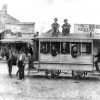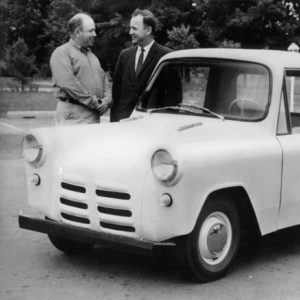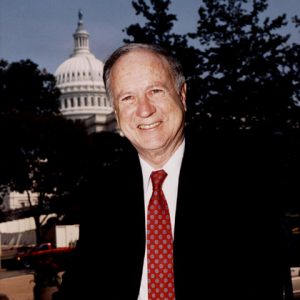calsfoundation@cals.org
Handywagon
The Handywagon, built in 1964 for the Arkansas Louisiana Gas Company (Arkla), was intended as an economical vehicle for use by the company’s Gaslite and domestic appliance servicers, meter readers, collectors, and meter setters. The small wagon was designed to be easily reparable and average thirty-five miles per gallon.
In mid-1963, Arkla board chairman Wilton “Witt” R. Stephens asked company lawyer Raymond Thornton to design a utility vehicle that could operate economically, have a 900-pound load capacity, weigh less than a ton and a half, and be company-built. In 1964, Thornton chose Ed Handy, a company construction engineer, to collaborate with him on the project. After much research, the two men found the power train they needed in Holland.
Van Doorne Automobielfabrieken of Endihoven produced a “variomatic” transmission with a two-cylinder, thirty-horsepower engine. The small truck would have a four-wheel independent suspension, making it able to track in mud and on ice. Another innovation was to have a steel frame covered by a fiberglass cab that could be easily replaced if damaged.
The Dutch components that were used were shipped to Ed Handy’s shop in Little Rock (Pulaski County), where the wagons were manufactured. The Razorback Boat Company at Malvern (Hot Spring County) made the fiberglass bodies and sent them to Handy’s shop. The initial run was for 100, at a per-wagon cost of $1,450; ninety-seven were made at a rate of one per day. The first “Handywagons,” as they were called, went into use in May 1964 as test models and were a success. In fact, their simple design meant there were few bugs to work out, and most repairs could be made in the field. Thornton wrote in the wagon’s operator’s manual, “The Handywagon is of very simple construction. It was designed and built in a home workshop by a pipeline construction foreman and a lawyer, so any automobile mechanic should be able to figure it out.”
Chairman Stephens was impressed with the Handywagon and asked Thornton and Handy for 1,000 more if they could reduce costs to $1,000 per vehicle. If so, Arkla would build a permanent factory, making Arkansas an automobile manufacturing center. Unfortunately, after much effort, Thornton and Handy reported to Stephens that the best they could offer was a base cost of $1,240. Stephens thought this too high, and so the project was dropped and the opportunity lost. After the oil and gas crisis of the 1970s, Stephens told Thornton he wished they had continued the Handywagon.
The Handywagons which were built were in service for over a decade before being phased out. There are currently three known Handywagons in existence. The Grant County Museum has one, Arkla has one, and the other is in the Van Doorne Automobielfabrieken Museum in Endihoven, Holland.
For additional information:
“Ark La’s ‘Handy Wagon,’ Arkansas-Produced Truck, To Be Tested in Five States.” Arkansas Gazette, February 4, 1965, p. 10A.
“Arkla’s ‘Handy-Wagon’ Proves Versatile, Economical Vehicle.” American Gas Journal, April 1965, 41–42.
“For Own Use: Arkla Building Compact Trucks.” Arkansas Democrat, February 3, 1965, 10A:1.
Paul Haynie
Harding University







Ed Handy is my uncle; he was married to Lola Handy, my aunt. This is fascinating. I remember going out to the shop and seeing one being worked on.
My dad, Jim Lashlee, worked with Mr. Handy during this time. He was a pipeline welder who was recruited to help build the Handywagons.
After finding this article, I now know that I have the rear part of a Handywagon. My grandfather turned it into a trailerI suppose from a damaged one or after they were phased out. Its possible someone in the shop did the welding for him; he worked for Arkla driving a semi back then. I got the trailer after he died and used it for quite a while, but its been sitting up for about ten years now. I plan on restoring it and using it again this summer. It has steel front and back plates with fiberglass sides. I always thought it was cool with the independent suspension, the coil springs, and shocks. There are still perfect brakes inside the drums. It has 13-inch wheels with only 3 lugs. I have one extra wheel to mount a spare tire. It tracks quite nicely behind my 1969 Corolla.